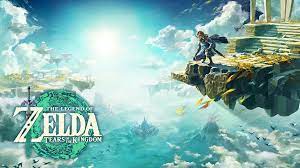
The following review contains light gameplay spoilers for “The Legend of Zelda: Tears of the Kingdom.”
It seems oddly fitting that my final article for The Pitch will be a review of “The Legend of Zelda: Tears of the Kingdom.” The wait for this game, known for much of the time as simply “The Sequel to ‘The Legend of Zelda: Breath of the Wild’”, has spanned my entire high school career. I remember watching the initial announcement with bated breath on one of the last days of middle school, rushing to my computer after my last Zoom class of 10th grade to view another minute of gameplay and taking a break from working on my college applications to see the name review trailer in September of last year.
Needless to say, a heavy weight of expectations surround this game. “Breath of the Wild” was a revolutionary title that brought the Zelda franchise into the current console generation while also pioneering the open world genre further than previous tent pole games such as “Grand Theft Auto 5” and “The Witcher 3.” It’s been over 6 years of development since “Breath of the Wild” was released concurrently with the Switch in 2017, so what exactly can gamers expect heading into this newest release?
Simply put, “Tears of the Kingdom” expands upon all of “Breath of the Wild’s” triumphs, surpassing the original in many regards in a game that, somehow, manages to be even larger and more complex than its predecessor.
The bare bones of both games are largely the same — Zelda has (shockingly) been captured, and it’s up to Link to embark on a globetrotting adventure to save her. Along the way, he’ll encounter a variety of faces both new and old, friend and foe. While the physical makeup of Hyrule is the same as the previous game, each location has new experiences, activities and things to explore.
The core gameplay difference comes in the new level of creativity that the game allows. One ability acquired very early on in the game, Super Hand, allows players to combine different objects together in order to create relatively complex vehicles and structures. Another ability, Merge, allows the player to combine any material with any weapon, enabling the creation of anything from a much longer spears to enemy-seeking arrows to even fire breathing spears. It ensures that there are always new things to do in the game and ensures that you can make useful items out of anything that you collect in the game.
The game’s abilities allow for deeper interaction with the game’s world, crafting an experience which is further bolstered by the game’s stellar presentation. The UI has been streamlined and simplified, and a number of quality of life changes ranging from the ability to swap powers via a sleeker wheel interface as well as the ability to drop weapons when taking a new item from a chest with a full inventory.
The soundtrack shines yet again, providing a heroic sense of adventure to the game. The graphical presentation is strong, though this largely thanks to the cel shaded art style as the relatively low power of the Switch holds the game back from a more striking appearance typical of modern AAA releases. Nevertheless, the performance of the game, though capped at thirty frames per second at times and hindered by occasional drops during hectic action, is solid
considering the age of the hardware and the magnitude of the game world and physics engine.
“Tears” is another masterful addition to the legacy of The Legend of Zelda series. In almost every area, it meets or exceeds the dizzying heights set by series tent poles such as “The Legend of Zelda: Ocarina of Time” or “The Legend of Zelda: Twilight Princess” and even last year’s “Elden Ring.” It’s evident that “Tears” is something truly special, and I can’t wait to spend dozens more hours exploring all that the game has to offer.


































